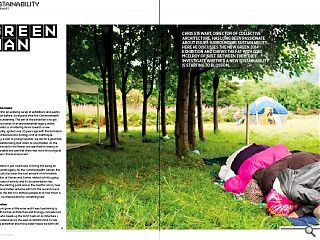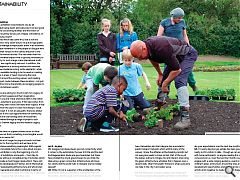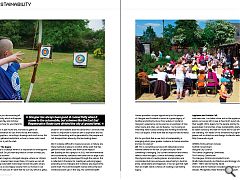Sustainability - Green Man
7 Aug 2014
Chris Stewart, director of Collective Architecture, has long been passionate about issues surrounding sustainability. Here he discusses the new green 2014 exhibition and chews the fat with Lori Mcelroy of sust. Between them they investigate whether a new sustainability is starting to blossom.
GREEN 2014, an evolving series of exhibitions and events undertaken before, during and after the Commonwealth Games, is underway. The aim of the exhibition is to get behind the scenes of an environmental legacy, within which I detect a smoldering move towards a new sustainability. Ignited over 20 years ago with the formation of the Architecture and Ecology Unit at Strathclyde University, a cast of young hopefuls, we ran for a good few seasons before being shut down as unorthodox. As the bee is attracted to the flower, we searched for beauty in the sustainable and saw that there was more to ecological design than clinical assessment.The exhibition is just round one, to bring into being an environmental legacy for the Commonwealth Games; the first difficulty has been the vast amount of information and number of Games and Games related activity going on. This scale of activity and its documentation has become the starting point and as the months roll on, how all of these activities entwine will form the second round. Right now, the aim is to enthuse people as to how much is going on, be inspired and try something new.
Young guns grow a little wiser and it was heartening to speak with former Architecture and Ecology comrade Lori McElroy, who heads up the SUST team at Architecture + Design Scotland and is the lead on GREEN 2014; to talk about the exhibition and those wider hopes we both still foster.
CS. Lori, the exhibition looks fantastic we are all impressed, but being devil’s advocate was it not just good business to re use existing facilities and the notion of sustainably recycling venues just a happy coincidence, or was this genuine intent?
LM. Who cares which idea came first, that is not the point; we have a very clever way to recycle a huge public resource and manage a major public event in an economic manner. Please remember it is the people of Glasgow who are lending their venues to the Games and prior to the bid 70% of the venues existed. This has meant that the major environmental impact that is typically necessary to prepare a city for such a large-scale international multi-sport event, was significantly reduced. In addition, the reuse and adaptation of existing venues also removed the risk of new stadia becoming ‘white elephants’, while allowing the available funding to be focused on creating new facilities in areas of need; improving the local environment around the existing venues; and creating better transport routes between these locations - not just road and rail but more importantly encouraging people to walk and cycle between events.
CS. Surely you are asking too much to aim for a legacy to be generated from people and their imagination.
LM. No, both you and I have enormous faith in the notion that there is potential in everyone, If this idea comes from the people, they own it and it will have their respect, if that idea comes from the users it is also more likely to result in follow through. It is not an easy path, there are always difficulties but in this case opportunities for community participation and overcoming some of the barriers have been created through a range of projects such as Glasgow’s Greener legacy and the National Legacy programmes.
CS. It will take time for a green infrastructure to show results, do you not think something more tangible would be have been an easier fix?
LM. It will take a bit longer for physical results but then legacy means for the long-term and we have to be patient to achieve something meaningful. With regards to the more immediate future this is also about process. The current exhibition is only the beginning of a rich programme of exhibitions and events – from May to October there will be an incredible array of activities which interlink to create a much bigger ripple effect. These will continue to be developed post-Games and in themselves create a self-perpetuating infrastructure and who knows what we will generate and what it will bring in terms of real capital. Sowing these seeds across the city creates the potential for a legacy that will outlive us all.
CS. Glasgow has always been good at connectivity when it comes to the automobile, the new M74 link and the East End Regeneration Route are good examples, but these have divided the city at ground level. Do you think the idea using a green connective infrastructure will move too slowly and the event hubs in Glasgow are too widely spaced?
LM. While I’m not a supporter of the proliferation of the automobile, what you describe is a hangover from the Bruce Plan, and the roads and motorways are I’m afraid here. Remember also that Glasgow has a wonderful public transport network which will link many of the venues. I know the athletes will be breaking records but not everyone needs to move so fast. Part of the joy of the Games will be to mingle, mix and interact, improving the green infrastructure will allow this to happen over a decent walk, often from public transport, where everyone can take in the city in a broader sense.
CS. Has there been a decent uptake to the events and have many visitors attended the exhibition so far. What are your expectations over the next few months?
LM. It is early days but yes uptake has been good with nearly 6,000 visitors to date - though we can always do with more participants, so anyone reading this please come and join us. Over the next four months we will engage with a wide-ranging audience, events include: children’s plays, active tours around the sites, professional development opportunities and exploring how all of this activity knits together to create that much bigger impact. Details are all on our web site, please come and join in and do your bit to create a green legacy.
CS. Are you documenting all the activity which will happen between May and October and if so how do you intend to use it?
LM. This is just round one, we have to gather all the information we can.There will be film makers, photographers, recordings, drawings and much more, this will be gathered and inform us how to move onto round two. This is just the start.
Act 3 - The legacy
CS. This is a catalyst where it is impossible to envisage the end result. Do you have any kind of a vision of what you hope to achieve?
LM. I can imagine a changed Glasgow, where our citizens want a Greener Dear Green Place. Of course we can all imagine redundant motorways turned into parks where we move as one happy society from our homes to our work. I’m not sure if I want that for our City which is gallus, stubborn and resilient all at the same time. I do know, that while it is important to have an aim or aspiration this has to have the backing and be generated by the people and not dropped from above by the few looking down.
CS. It is always difficult to measure success or failure, are there methods in place to monitor all the work that has gone into these Games and their future impact?
LM. Building on the Olympics in 2012, new environmental and sustainability standards have been set for large scale events that are being developed through the Games, this is reflected in the plans for creating an enduring legacy extending across Glasgow and Scotland, way beyond the event itself. The Commonwealth Games will be the best monitored event yet. In this way, the Commonwealth Games provides a unique opportunity for the people of Glasgow and Scotland in terms of a green legacy of facilities and infrastructure. More widely in Scotland, Glasgow’s experience can be used as an exemplar of how other towns and cities can do likewise – by focusing on what they have in place already and working around that. This is an aspect of the work that we hope to take forward.
CS. Do you think that a new form of sustainability is emerging which gives greater credence to human emotion and less to science?
LM. This is something we have both talked about and worked toward for the last 20 years and yes I think something is emerging. Our current exhibition and events reflects these thoughts, science will always underpin the physical side of creating places, and emotions are complicated but here we have an opportunity to build on pride, camaraderie and happiness. If we can get that right then we might stand a chance of creating a real lasting legacy.
Interview over, Lori takes a bow and as the applause peters out we are left in awe at how SUST punch above their weight. Will a legacy for the people and by the people bear fruit and has a New Sustainability started to be taken seriously. We wait for round two to see who is still standing. For details of the GREEN2014 programme please visit Architecture and Design Scotland’s website at http://www.ads.org.uk
|
|
Read next: AHR: What's in a Name?
Read previous: Scottish Design Awards - Fire Alarm
Back to August 2014
Browse Features Archive
Search
News
For more news from the industry visit our News section.
Features & Reports
For more information from the industry visit our Features & Reports section.





